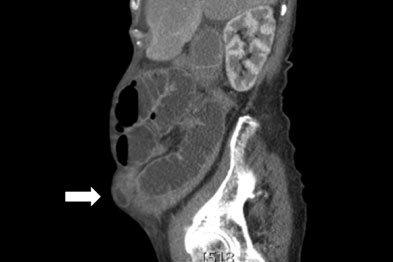The omental hernia is a rare but complicated condition. There are only a few cases reported throughout the world. The intestines are obstructed with the hernia that leads to life-threatening complications. It is mostly a challenging case for emergency surgeons. The sole reason is that the symptoms are not specified clearly.
The protrusion of organs in the abdominal cavity is a common sign of hernias. For the precise diagnosis and treatment, and abdominal CT scan can be helpful to reduce the risk of complications during or after the surgery. The overlapping of symptoms with gastrointestinal diseases makes it a difficult diagnosis.
Elderly patients are at greater risk of intestinal obstruction and surgery failure. The rate of mortality in patients is quite, nearly up to 75%. The normal shape of mesenteric vessels and the blood supply can be evaluated through a series of lab tests. Necrosis of the intestines can be observed as well.
Omental Hernia Complications
Omental hernia complications escalate rapidly. The common complication of hernias includes obstruction of the bowel. This bowel obstruction is secondary to other conditions like hernia itself, strangulation, and incarceration. Clinical evaluation is necessary to evaluate these complications.
The symptoms most commonly experienced to detect these issues are vomiting, distension, and excruciating abdominal pain, which is unbearable. The abdominal mass is firm and tender when it is physically examined by the doctor. If these complications are left untreated, other problems arise like severe dehydration, peritoneal signs, and distension.
The clinical manifestations are often inconclusive and peri-operative assessment is recommended in most cases. The grade of obstruction is identified with the imaging techniques used. Moreover, the compromised blood supply can lead to ischemia. The afferent bowel loops are affected in this case.
Trauma is also one of the complications related to an Omental hernia. It can be either caused due to a hernia or the hernia might be the reason for pre-existing trauma.
Omental Hernia Symptoms
The common symptom of a hernia is sharp, burning, and stabbing pain at the location. This is due to the inflammation of nerves. Sometimes, it can be felt during clinical examination but it is painless. When the hernia sac is obstructed with a piece of the intestine, complications arise.
Hernia can also be obstructed by a piece of bowel and it cannot be excreted. This can also lead to surgical emergency if the bowel has swelling because this is the common cause of strangulation. Nausea and vomiting are quite commonly associated signs and symptoms of omental hernia.
Some patients can also have mild to high fever especially with the complications of omental hernia. Burning chest pain, gastroesophageal reflux disorder, and sour taste of the mouth are the other symptoms linked with the omental hernia. The stomach acids are responsible for the regurgitation in the mouth and throat.
Omental Hernia Causes
The causes of omental hernia can either be congenital or develop with time due to the weakness of muscles in the abdominal region. When the pressure on the abdominal cavity is increased, the pain is triggered at the weak points. This will cause the protruding of parts in the abdomen known as a hernia.
The pressure on the abdomen can be initiated due to a variety of reasons. These include:
- Chronic cough
- Ascites(the fluid is increased in the abdominal cavity)
- Peritoneal dialysis which is a common treatment of kidney failure
- Existing tumors in the abdomen
- Lifting excessive weight
- Straining to have a bowel movement
- Pregnancy
- Trauma
- Excess abdominal fat
The hernias lead to weakness of the abdominal cavity. The risk factors include constipation, recurrent vomiting, and surgeries of the abdomen.
Omental Hernia Surgery
Emergency laparotomy is a surgical procedure, which is often recommended to patients diagnosed with an omental hernia. Tension-free mesh repair is the standard surgical procedure for omental hernia, regardless of the size.
The mesh is placed in preperitoneal space. The approach of surgery can be a laparoscopic or open end. The mesh is of different types. Polypropylene is most commonly used in the surgeries of omental hernia. It is a non-absorbable material that is incorporated into the tissues rapidly.
Certain complications may arise after the surgery of an omental hernia. These include the accumulation of excessive fluid. Sometimes it is resolved on its own within 30 days. In a few cases, it takes up to 6 weeks. Moreover, after 2-3 years of surgery, there is a possibility of recurrence. 1-5% of patients also experience infections post-operation.
 Health & Care Information
Health & Care Information



